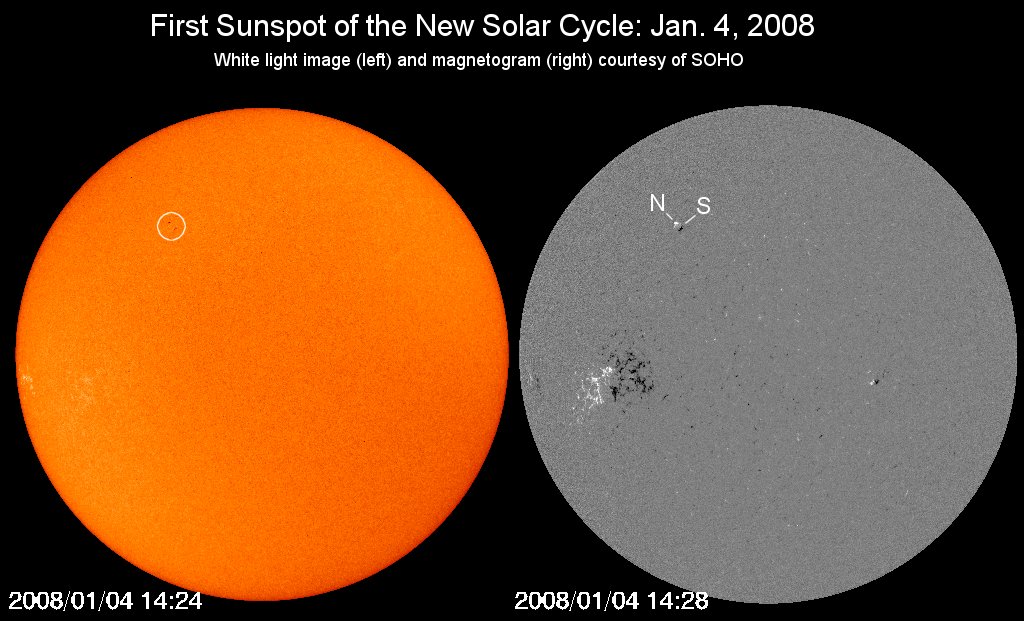by neufer » Wed Jun 09, 2010 7:03 pm
Mizzou wrote:Hi all, I am new to the message boards here but have been following APOD for over a year or so. I have a question about solar cycles. When did cycle 23 end, and 24 start? I read the link from New Scientist, but was not really clear on what the current situation is. Is there even a clear-cut distinction between the two cycles right now? Thanks!
Hi Mizzou,
Solar Cycle 24 officially started when:
"a magnetically reversed, high-latitude sunspot, dubbed as number 981, was first observed" on January 4, 2008.
http://wattsupwiththat.com/2008/01/04/solar-cycle-24-has-officially-started/ wrote:
Solar Cycle 24 has officially started
Posted on January 4, 2008 by Anthony Watts
<<Solar physicists have been waiting for the appearance of a reversed-polarity sunspot to signal the start of the next solar cycle.
The signal for the start of a new cycle is sighting a particular kind of sunspot. That wait is over.
A magnetically reversed, high-latitude sunspot, dubbed as number 981, emerged on the surface of the sun today.
This reversed polarity sunspot today marks the beginning of Solar Cycle 24 and the sun’s return back to Solar Maximum.
New cycle sunspot: South magnetic pole precedes North magnetic pole in northern hemisphere sunspot

Old cycle sunspot: South magnetic pole precedes North magnetic pole in southern hemisphere sunspot
................................................................
This from ESA may help everyone understand the transition:
- With the next solar cycle this [sunspot magnetic] orientation is flipped in both hemispheres, as the Sun’s global magnetic field reverses its orientation. As a new cycle begins, the number of sunspots with the reverse orientation will increase and the ones with the orientation of the old cycle will decrease in number. In the transition period they can both occur on the Sun, as the two cycles have no sharp boundary and overlap
.>>
http://en.wikipedia.org/wiki/Solar_cycle wrote:
Time vs. solar latitude diagram of the radial component of the solar magnetic field, averaged over successive solar rotation. The "butterfly" signature of sunspots is clearly visible at low latitudes. Diagram constructed (and regularly updated) by the solar group at NASA Marshall Space Flight Center.

[quote="Mizzou"]Hi all, I am new to the message boards here but have been following APOD for over a year or so. I have a question about solar cycles. When did cycle 23 end, and 24 start? I read the link from New Scientist, but was not really clear on what the current situation is. Is there even a clear-cut distinction between the two cycles right now? Thanks![/quote]
Hi Mizzou,
Solar Cycle 24 officially started when:
"a magnetically reversed, high-latitude sunspot, dubbed as number 981, was first observed" on January 4, 2008.
[quote=" http://wattsupwiththat.com/2008/01/04/solar-cycle-24-has-officially-started/"]
Solar Cycle 24 has officially started
Posted on January 4, 2008 by Anthony Watts
<<Solar physicists have been waiting for the appearance of a reversed-polarity sunspot to signal the start of the next solar cycle.
The signal for the start of a new cycle is sighting a particular kind of sunspot. That wait is over.
A magnetically reversed, high-latitude sunspot, dubbed as number 981, emerged on the surface of the sun today.
This reversed polarity sunspot today marks the beginning of Solar Cycle 24 and the sun’s return back to Solar Maximum.
[size=125][b][color=#FF0000]New cycle sunspot: South magnetic pole precedes North magnetic pole in northern hemisphere sunspot[/color]
[img]http://www.spaceweather.com/images2008/04jan08/newspot.jpg[/img]
[color=#0000FF]Old cycle sunspot: South magnetic pole precedes North magnetic pole in southern hemisphere sunspo[/color]t[/b][/size]
................................................................
This from ESA may help everyone understand the transition:
[list]With the next solar cycle this [sunspot magnetic] orientation is flipped in both hemispheres, as the Sun’s global magnetic field reverses its orientation. As a new cycle begins, the number of sunspots with the reverse orientation will increase and the ones with the orientation of the old cycle will decrease in number. In the transition period they can both occur on the Sun, as the two cycles have no sharp boundary and overlap[/list].>>[/quote]
[quote=" http://en.wikipedia.org/wiki/Solar_cycle"]
Time vs. solar latitude diagram of the radial component of the solar magnetic field, averaged over successive solar rotation. The "butterfly" signature of sunspots is clearly visible at low latitudes. Diagram constructed (and regularly updated) by the solar group at NASA Marshall Space Flight Center.
[img]http://upload.wikimedia.org/wikipedia/en/thumb/3/33/Synoptic-solmag.jpg/700px-Synoptic-solmag.jpg[/img][/quote]